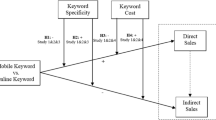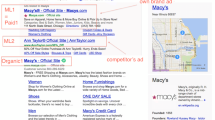Abstract
For the management of paid search advertising campaigns, metrics collected at keyword-level are often used in practice whereas the users’ search process is of secondary importance and thus wholly or partially neglected. In contrast to brand-related keywords (“T-mobile contract”), general keywords, often referred to as generic (“mobile phone contract”), seem at first glance to be economically unattractive. Extending the approach of Rutz and Bucklin, Journal of Marketing Research, 48(1):87–102 (2011), we investigate the role of generic search activities in paid search advertising across industries using dynamic linear models (DLM). The so-called spillover effect, i. e. the increase in brand-related awareness effected by displaying ads for generic keywords, is investigated by both analyzing individual consumer behavior on the basis of keyword-level data and linking findings on keyword- with findings on individual user-level data. We show that the spillover effect varies across industries and that its consideration, for example for the mobile phone provider investigated here, decreases KPIs such as the cost per order up to 42 %.


Similar content being viewed by others
References
Agarwal, A., Hosanagar, K. & Smith, M. D. (2011). Location, location, location: an analysis of profitability of position in online advertising markets. Journal of Marketing Research, 48(6), 1057–1073.
Animesh, A., Viswanathan, S., & Agarwal, R. (2011). Competing “creatively” in sponsored search markets: the effect of rank, differentiation strategy, and competition on performance. Information Systems Research, 22(1), 153–169.
Arora, R. (1982). Validation of an s-o-r model for situation, enduring, and response components of involvement. Journal of Marketing Research, 19(4), 505–516.
Athey, S. & Ellison, G. (2009): Position auctions with consumer search. http://ssrn.com/abstract=1454986.
Barki, H., & Hartwick, J. (1989). Rethinking the concept of user involvement. MIS Quarterly, 13(1), 53–63.
Barki, H., & Hartwick, J. (1994). Measuring user participation, user involvement, and user attitude. MIS Quarterly, 18(1), 59–82.
Broder, A. (2002). A taxonomy of web search. SIGIR Forum, 36(2), 3–10.
Cho, C. H., & Cheon, H. J. (2004). Why do people avoid advertising on the internet? Journal of Advertising, 33(4), 89–97.
Danaher, P. J., & Mullarkey, G. (2003). Factors affecting online advertising recall: a study of students. Journal of Advertising Research, 43(3), 252–267.
Edelman, B., & Ostrovsky, M. (2007). Strategic bidder behavior in sponsored search auctions. Decision Support Systems, 43(1), 192–198.
Edwards, S. M., Li, H., & Lee, J. H. (2002). Forced exposure and psychological reactance: antecedents and consequences of the perceived intrusiveness of pop-up ads. Journal of Advertising, 31(3), 83–95.
eReleases (2010). Statistics highlighting the importance of SEO press releases. Retrieved September 10, 2011, from http://www.ereleases.com/prfuel/statistics-seo-press-releases/.
Feldman, J. S., Muthukrishnan, M. & Stein, C. (2007). Budget optimization in search-based advertising auctions. EC '07 Proceedings of the 8th ACM Conference on Electronic Commerce, pp. 40–49.
Ghose, A., & Yang, S. (2009). An empirical analysis of search engine advertising: sponsored search in electronic markets. Management Science, 55(10), 1605–1622.
Interactive Advertising Bureau (2011). Internet advertising revenues hit $7.3 billion in Q1′11: Highest first-quarter revenue level on record according to IAB and PWC. Retrieved September 10, 2011, from http://www.iab.net/about_the_iab/recent_press_releases/press_release_archive/press_release/pr-052611/.
Jansen, B. J., & Spink, A. (2007). The effect on click-through of combining sponsored and non-sponsored search engine results in a single listing. In Proceedings of the 2007 Workshop on Sponsored Search Auctions, Banff, AB, Canada.
Jansen, B. J., Spink, A., & Saracevic, T. (2000). Real life, real users, and real needs: a study and analysis of user queries on the web. Information Processing and Management, 2(36), 207–227.
Jansen, B. J., Spink, A., Blakely, C., & Koshman, S. (2007). Defining a session on web search engines. Journal of the American Society for Information Science and Technology, 58(6), 862–871.
Jerath, K., Ma, L., Park, Y. H., & Srinivasan, K. (2011). A ‘position paradox’ in sponsored search auctions. Management Science, 30(4), 612–627.
Kitts, B., & Leblanc, B. (2004). Optimal bidding on keyword auctions. Electronic Markets, 14(3), 186–201.
Laurent, G., & Kapferer, J. N. (1985). Measuring consumer involvement profiles. Journal of Marketing Research, 22(1), 41–53.
Li, J., Pan, R., & Wang, H. (2010). Selection of best keywords: a poisson regression model. Journal of Interactive Advertising, 11, 27–35.
Manchanda, P., Dubé, J. P., Goh, K. Y., & Chintagunta, P. K. (2006). The effect of banner advertising on internet purchasing. Journal of Marketing Research, 43(1), 98–108.
Moe, W. W. (2003). Buying, searching, or browsing: differentiating between online shoppers using in-store navigational clickstream. Journal of Consumer Psychology, 13(1–2), 29–39.
Nerlove, M., & Arrow, K. J. (1962). Optimal advertising policy under dynamic conditions. Economica, 29(114), 129–142.
Nottorf, F., Mastel, A. & Funk, B. (2012). The user-journey in online search: an empirical study of the generic-to-branded spillover effect based on user-level data. In Proceedings of DCNET, ICE-B and OPTICS 2012: SciTePress, S. 145–154.
Petris, G., Petrone, S., & Campagnoli, P. (2009). Dynamic linear models with R. New York: Springer.
Rusmevichientong, P., & Williamson, D. P. (2006). An adaptive algorithm for selecting profitable keywords for search-based advertising services. EC '06 Proceedings of the 7th ACM Conference on Electronic Commerce, pp. 260–269.
Rutz, O. J., & Bucklin, R. E. (2007). A model of individual keyword performance in paid search advertising. http://ssrn.com/abstract=1024765.
Rutz, O. J., & Bucklin, R. E. (2011). From generic to branded: a model of spillover in paid search advertising. Journal of Marketing Research, 48(1), 87–102.
Rutz, O. J., Trusov, M., & Bucklin, R. E. (2011). Modeling indirect effects of paid search advertising: which keywords lead to more future visits? Marketing Science, 30(4), 646–665.
Search Engine Watch (2004). Delving deep inside the searcher’s mind. Retrieved September 10, 2011, from http://searchenginewatch.com/article/2064150/Delving-Deep-Inside-the-Searchers-Mind/.
Varian, H. R. (2007). Position auctions. International Journal of Industrial Organization, 25(6), 1163–1178.
Varian, H. R. (2009). Online ad auctions. American Economic Review, 99(2), 430–434.
West, M., & Harrison, J. (1997). Bayesian forecasting and dynamic models (2nd ed.). New York: Springer.
Yao, S., & Mela, C. F. (2009). Sponsored search auctions: research opportunities in marketing. Foundations and Trends in Marketing, 3(2), 75–126.
Zaichkowsky, J. L. (1994). The personal involvement inventory: reduction, revision, and application to advertising. Journal of Advertising, 23(4), 59–70.
Acknowledgments
We are indebted to Oliver J. Rutz and Thomas Otter for their support and helpful suggestions. We wish to thank the collaborating firms for providing the data used in this study as well as the anonymous reviewers for their valuable comments which have enabled us to make this work far more generalizable and accessible.
Author information
Authors and Affiliations
Corresponding author
Additional information
Responsible editor: Christopher Patrick Holland
Rights and permissions
About this article
Cite this article
Nottorf, F., Funk, B. A cross-industry analysis of the spillover effect in paid search advertising. Electron Markets 23, 205–216 (2013). https://doi.org/10.1007/s12525-012-0117-z
Received:
Accepted:
Published:
Issue Date:
DOI: https://doi.org/10.1007/s12525-012-0117-z




